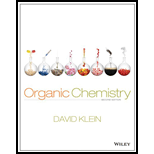
(a)
Interpretation: The molecular ion peak from the given mass spectra should be determined.
Concept Introduction:
Mass spectroscopy: It is a form of spectroscopic technique which is used for the elucidation of the molecular formula and molecular weight of the compound, depending upon the mass of the molecule.
The
The
Molecular formula: It represents the types of atoms with their total number present in a given molecule.
Molecular ion peak: It is defined as the heaviest peak in the mass spectrum of the molecule which represents the largest molecular ion in the given molecule with greater m/z value.
Base peak: It is the tallest peak in the spectrum.
(b)
Interpretation: The base peak from the given mass spectra should be determined.
Concept Introduction:
Mass spectroscopy: It is a form of spectroscopic technique which is used for the elucidation of the molecular formula and molecular weight of the compound, depending upon the mass of the molecule.
The
The
Molecular formula: It represents the types of atoms with their total number present in a given molecule.
Molecular ion peak: It is defined as the heaviest peak in the mass spectrum of the molecule which represents the largest molecular ion in the given molecule with greater m/z value.
Base peak: It is the tallest peak in the spectrum.
(c)
Interpretation: The structure of the fragment that produces the base peak from the given mass spectra should be determined.
Concept Introduction:
Mass spectroscopy: It is a form of spectroscopic technique which is used for the elucidation of the molecular formula and molecular weight of the compound, depending upon the mass of the molecule.
The
The
Molecular formula: It represents the types of atoms with their total number present in a given molecule.
Molecular ion peak: It is defined as the heaviest peak in the mass spectrum of the molecule which represents the largest molecular ion in the given molecule with greater m/z value.
Base peak: It is the tallest peak in the spectrum.
Want to see the full answer?
Check out a sample textbook solution
Chapter 15 Solutions
Organic Chemistry
 ChemistryChemistryISBN:9781305957404Author:Steven S. Zumdahl, Susan A. Zumdahl, Donald J. DeCostePublisher:Cengage Learning
ChemistryChemistryISBN:9781305957404Author:Steven S. Zumdahl, Susan A. Zumdahl, Donald J. DeCostePublisher:Cengage Learning ChemistryChemistryISBN:9781259911156Author:Raymond Chang Dr., Jason Overby ProfessorPublisher:McGraw-Hill Education
ChemistryChemistryISBN:9781259911156Author:Raymond Chang Dr., Jason Overby ProfessorPublisher:McGraw-Hill Education Principles of Instrumental AnalysisChemistryISBN:9781305577213Author:Douglas A. Skoog, F. James Holler, Stanley R. CrouchPublisher:Cengage Learning
Principles of Instrumental AnalysisChemistryISBN:9781305577213Author:Douglas A. Skoog, F. James Holler, Stanley R. CrouchPublisher:Cengage Learning Organic ChemistryChemistryISBN:9780078021558Author:Janice Gorzynski Smith Dr.Publisher:McGraw-Hill Education
Organic ChemistryChemistryISBN:9780078021558Author:Janice Gorzynski Smith Dr.Publisher:McGraw-Hill Education Chemistry: Principles and ReactionsChemistryISBN:9781305079373Author:William L. Masterton, Cecile N. HurleyPublisher:Cengage Learning
Chemistry: Principles and ReactionsChemistryISBN:9781305079373Author:William L. Masterton, Cecile N. HurleyPublisher:Cengage Learning Elementary Principles of Chemical Processes, Bind...ChemistryISBN:9781118431221Author:Richard M. Felder, Ronald W. Rousseau, Lisa G. BullardPublisher:WILEY
Elementary Principles of Chemical Processes, Bind...ChemistryISBN:9781118431221Author:Richard M. Felder, Ronald W. Rousseau, Lisa G. BullardPublisher:WILEY





